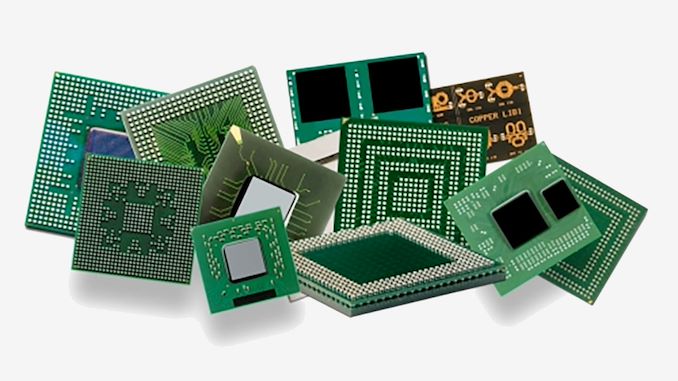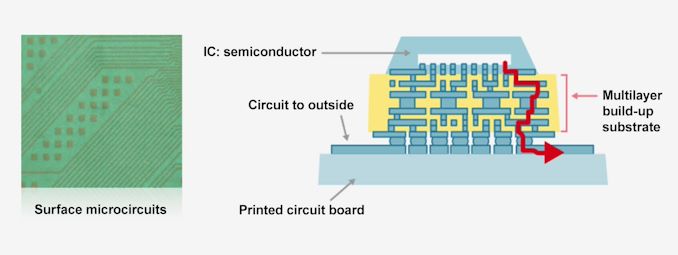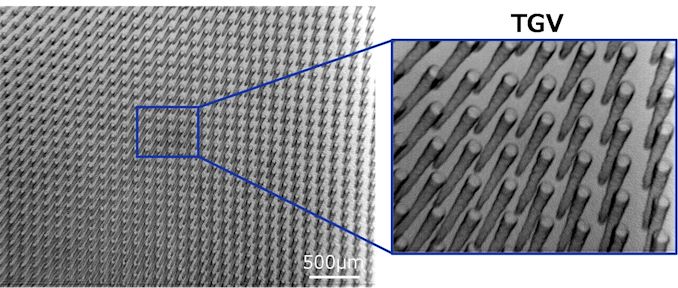Out With Organic, In With Glass? DNP Unveils Glass Core Substrate Tech For Chips
by Anton Shilov on March 23, 2023 11:00 AM EST- Posted in
- Semiconductors
- Packaging
- DNP
- Dai Nippon Printing

As the chip industry develops more sophisticated processors with higher heat dissipation requirements, some firms have moved on to chiplet-based designs. This not-so-gradual shift has resulted in chip packaging technologies becoming increasingly important. Large and highly complex chips such as Nvidia's H100 and advanced multi-chip solutions like Intel's Data Center Max GPU (Ponte Vecchio) present new requirements for packaging materials. To that end, Dai Nippon Printing (DNP) is showcasing a new development for semiconductor packages – Glass Core Substrate (GCS) – which it says can address many of those challenges.
Typically, modern chips are installed on fine pitch substrates (FPS), which are then put on multi-layer high-density interconnect (HDI) substrates. The most advanced CPU/GPU HDI substrates these days use Ajinomoto Build-up Film(ABF), which combines organic epoxy resins, hardener, and inorganic microparticle filler, according to the manufacturer. It is easy to use, and it can achieve high-density pitching (thus enabling high density metal wiring), it has insulation properties that are good enough for modern chips, high rigidity, high durability, and low thermal expansion, among other factors.
Will ABF and other organic resin-based substrates still be good enough for chiplets? Well, it's quite a challenge, as these multi-chiplet designs will be more power-hungry (and thus hotter) and require metal writing of a higher density due to the widening of memory and I/O interfaces. This increase in power requirements puts added pressure on the outlying substructure of the circuitry. Finding new materials to use within the core makeup of chips within the semiconductor industry has been a hot pursuit for many years.
One such company in the semiconductor industry is Dai Nippon Printing (DNP), and they claim that their HDI substrates with a glass core have superior properties compared to organic resin-based substrates. According to Dai Nippon, using a glass core substrate (GCS) can enable finer pitching and, therefore, extremely dense wiring because it is stiffer and less prone to expansion due to high temperatures. A schematic drawing demonstrated by DNP even omits the fine pitch substrate from the packaging altogether, implying that this part may no longer be needed.
Perhaps, most notably, DNP claims its glass core substrate can offer high through glass via (TGV) density (compatible with FPS) with a high aspect ratio. The aspect ratio, in this case, is the ratio between the thickness of the glass and the diameter of the via. As the number of vias increases and the ratio increases, the processing of substrates gets harder, and maintaining the rigidity gets more challenging.
Glass is considered more rigid than organic resin-based substrates and has several advantages, but the adhesion between glass and copper (or other metal wires) is still a major challenge in regard to bonding. The DNP-developed glass substrate has an aspect ratio of 9 and ensures adhesiveness to enable fine pitch-compatible wiring. Since there are only a few GCS thickness constraints, there is a lot of freedom when it comes to maintaining a balance between thickness, warpage, stiffness, and smoothness, the company says.
Dai Nippon Printing produces out-coupling enhancement structures for LCDs and scattering for backlighting modules, so it has vast experience with the mass production of glass-based structures. Meanwhile, DNP is not the only specialist in rigid glass applications looking ahead to the future in making HDI substrates for advanced chips or multi-chiplet solutions. Corning has been exploring this area for quite a while, though it does not look like its technology is used commercially for high-volume chips or in multi-chip-modules.
Source: Dai Nippon Printing













17 Comments
View All Comments
Samus - Monday, March 27, 2023 - link
Fun fact, I went to Evergreen Park High School. In fact I still live 5 blocks away. Ted Kaczynski is still popular around here, more so than Jenny McCarthy.BvOvO - Friday, March 24, 2023 - link
You are mixing biologic and organic. Organic essentialy is carbon chemistry. So synthetic fibers that have carbon-carbon bonds are organic.Astrogardener - Friday, March 24, 2023 - link
Because epoxy is an organic compound. The word organic in this case means "carbon-based." Organic chemistry is a whole subfield of chemistry that deals with organic compounds.Threska - Friday, March 24, 2023 - link
V'Ger: Carbon-based unit.Kevin G - Thursday, March 23, 2023 - link
I know that one of the reasons the current organic substrates are still seen as viable for the future is that optical fibers can be embedded into current manufacturing. Part of these technologies were for off package communication while others were to improve die-to-die connectivity when silicon photonics became viable for mainstream adoption. One barrier to entry is the various patents here embedding optical fibers is spread throughout the industry. I assumed that some of these were handled in the cross licensing agreement between Intel and IBM a few years ago. My hope was that we'd be seeing such products in the future.With regards to glass substrates though, I would presume that this has a very similar thermal expansion rate to a silicon wafer itself. Normalizing expansion rates makes dealing with the mechanical stress of thermal cycles far, far easier. The embedded wiring might have the secondary effect of acting as a means to help transfer heat uniformly throughout the structure. My concern is that hot spots could lead to shattering the substrate if the internal stresses from thermal expansion are not handled well.
GC2:CS - Friday, March 24, 2023 - link
Hmm. So if by accident i manage to drop a new CPU (or a device containing it) by accident, will it break like a smartphone ?mode_13h - Sunday, March 26, 2023 - link
Well, let's say I'm not going to try dropping a CPU onto a concrete floor.If you drop a device *containing* a CPU, the device's case will probably absorb enough shock that I'd guess you won't have sufficient shear forces, at the substrate, to kill it. Also, having a thermal solution clamped onto it should help couple the entire package to the board, which should also help.